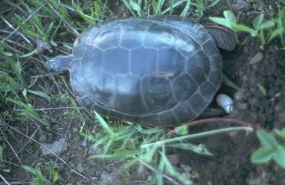
NPS Characteristics While the plastron of some of the other sub-species is a distinctive solid yellow, the Western Painted Turtle has the most distinctive plastron which is red or orange-red with a bold dark pattern of black with some yellow lines on the interior and with lobes that extend out along the scute margins giving it the appearance of an inkblot. The background skin color is olive green to black. The yellow lines on the head start by the eyes and snout and become orange-red on the neck and behind. The upper jaw has a notch just below the nostrils. Prey - The Living And The Dead Raccoons, squirrels, chipmunks, woodchucks, skunks, badgers, fox, crows, garter snakes, deer, ants, beavers and humans will prey on turtle nests. Newly hatched turtles are eaten by muskrats, raccoons, snapping turtles, snakes, bullfrogs, large fish, and herons. As they get bigger they face bigger predators such as alligators, bald eagles, osprey, and red shoulder hawks. Their shells do not offer full protection from predators. They fall prey to humans in a number of ways including habitat destruction, pesticides, vehicles on roads and capture as pets. Territory And Habitat Painted turtles like ponds, lakes, marshes and slow moving streams and rivers that have soft muddy bottoms with suitable basking sites and ample aquatic vegetation. The favorite basking sites are on partially submerged logs where they soak in the warmth of the sun. This helps them maintain their preferred body temperature and gives them the energy for their food to properly digest. They usually spend the night sleeping on the muddy bottom. During the winter they bury themselves deep in the mud and hibernate, or more technically brumate. Basically they go with what oxygen they need being absorbed from water through their skin. This prevents a buildup of lactic acid by slowing their metabolic rate and using magnesium and calcium stored in its shell to buffer and neutralize the acid. Brumation may last from 4 to 6 months in the northern portion of their range. Mating, Birth, And Lifespan As Painted Turtles are amniotes the females must nest on land and they prefer soft, slightly moist, sandy soil with good exposure to the sun. With her hind legs, the females dig a conical, flask shaped hole about 4 to 5 inches deep and lays 2 to 20 soft shelled, white to off white, elliptical eggs. The female covers the eggs and leaves the nest unattended. Females may lay up to five clutches, but the number per clutch declines. Larger females will lay more eggs per clutch. In 72 to 80 days the hatchlings use their caruncle (egg tooth) to emerge from the egg then dig their way to the surface and head for water. Their pigmentation is brighter than adults. The males reach sexual maturity in 3 to 5 years and the females in 4 to 6 years. Those that escape predation may live for well over 20 years. |
Last updated: February 24, 2015
